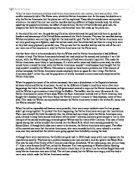How Useful is the Painting “American Progress” to a Historian Studying Reasons Why People Went West?
The “American Progress”, painted by John Gast in 1872, is a representation of the Manifest Destiny. The Manifest Destiny was the idea that the United States was destined by God to expand from the Atlantic seaboard to the Pacific Ocean. The painting would be very useful to a historian. On the painting an angelic-looking woman with a star on her head and a bible (or a school book) in her hand is seen bringing “light” to West. The side from where she is coming is light, and the West, where she is heading, is dark. This light can be interpreted as Christianity; highlighting the idea that the United States thought that by bringing Christianity to the West they also brought “light” to the Indians, whom they considered savage and barbaric. The Indians and the wild animals on the west side can be seen fleeing. The American settlers, farmers and cattlemen are seen following the angelic woman westward. Their farms and cattle are also seen, meaning the painting also gives some economic representation of the time. The different economic activities of the pioneers are shown as they are seen heading westward in the painting. This could be interpreted as them heading to the West for gold mining. The changing forms of transportation are also highlighted in this painting through the trains on the “United States” side, which also shows that the government encouraged people to go west. There is also a wagon with horses, which suggests that people travelled to the West in families. The woman is connecting telegraph poles, thereby binding the two nations, and the telegraph poles also show the advancements in communication. The painting’s main use is that it highlights the idea of the Manifest Destiny, as well as giving the historian other information about the time, such as the changing forms of transportation and the economic activities of the pioneers.







